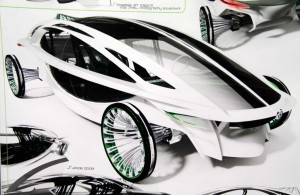Short of having four wheels, tomorrow’s automobiles may look very different from those of today as automakers adapt to a variety of challenges like fuel economy and safety regulations, overcrowded highways and other concerns.
So why not let the designers of tomorrow see what concepts they can come up with? That’s the premise behind the Michelin Challenge Design competition which turned to students at Detroit’s College for Creative Studies, one of the fertile sources for some of the best stylists in the industry today.
Now in its 24th year, the theme for the latest design competition was “Half! Lightweight with Passion,” putting the emphasis on slicing the weight of a typical vehicle without having to sacrifice room, comfort, safety and other factors. As might be expected, considering Michelin’s sponsorship, students were asked to come up with some interesting ways to advance tire and wheel technology as part of the process.
The goal was to focus on “everything important to the car,” explained Mark West, the competition’s sponsor and chairman of CCS’s Transportation Design Program. Book learning may be critical, he noted, but the annual challenge helps “make sure our students are prepared for life in the auto industry the moment they walk out the door.”
The project forced the student stylists to face many of the same challenges confronting those already working in automotive design and engineering studios. With U.S. fuel economy standards set to nearly double, to 54.5 mpg, by 2025, virtually every aspect of the automobile must be reconsidered.
That meant coming up with entirely new platforms which, the various teams agreed, will rely on electric propulsion to improve efficiency. They also turned to advanced materials such as carbon fiber, and put a premium on aerodynamics.
For student Yoongkyung Hwang, one of the challenge’s winners, “I chose a bicycle helmet for inspiration because it is very lightweight, strong and has very good aerodynamics.”
His design featured an unusual wheel and tire combination that re-envisioned the classic wire wheels design. His two-tone tires, in particular, were also a sort of retro-futuristic concept. Instead of whitewalls, however, they featured a silver-white band in the middle of the tread close to the natural color of rubber.
Other students and their teams took things even further when focusing on their tire designs — and for good reason considering that tire friction and other factors traditionally are responsible for wasting about 20% of the energy put out by an internal combustion engine or electric motor.
Several teams envisioned wheels and tires that could be electronically adjusted to help improve their efficiency. One team went so far as to conceive a way to use the tires to regenerate electricity, much like today’s hybrid powertrain systems.
“Twenty years ago, a tire was a round, black donut,” suggested program chairman West. “Today, manufacturers want it to play a bigger role in the car,” and the students’ work suggested various ways that might happen in the future.
“Part of the opportunity is that as vehicles get lighter, the size, shape and design of tires can change,” added Scott Pajtas, the director of Michelin’s Innovation Department.
He pointed to the undersized tires in use on the breakthrough Delta Wing, a dart-shaped race car that made its debut at the 24 Hours of Le Mans last June.
While some of the students’ concepts pushed into the realm of science fiction, jurors for the Michelin Design Challenge were impressed with the results – noting that most automakers have created their own advanced development operations charged with looking far beyond what might be practical today, hoping to set a course for the future.
“We wanted to see far-reaching ideas and far-reaching concepts,” said Scott Roller, a design with Toyota’s advanced CALTY Design Center – and himself a CCS graduate.
“These students will be running the design world in 20 years,” he added, “and we want them to think far beyond where we are today.”


“We wanted to see far-reaching ideas and far-reaching concepts,” said Scott Roller, a design with Toyota’s advanced CALTY Design Center – and himself a CCS graduate.
“These students will be running the design world in 20 years,” he added, “and we want them to think far beyond where we are today.”
What about this tandem of wheels (rotors):
http://www.pattakon.com/pattakonFly.htm
Can these 2 wheels move /translate a man through all the THREE dimensions of the space?
Without the need of any ROAD?
Over any land AND any sea?
With less fuel AND pollution, than your bike or car?
What makes you skeptical, the most?